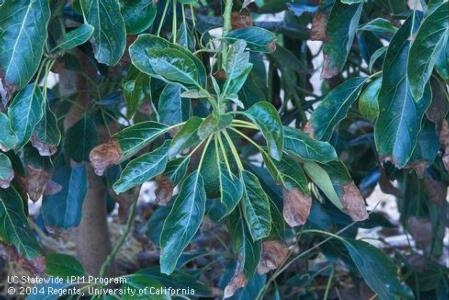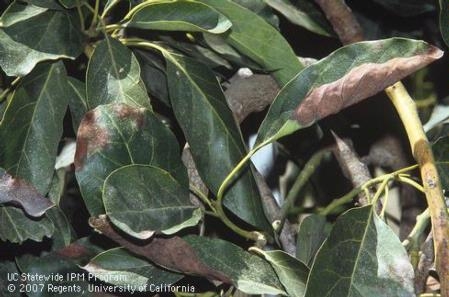The calls are coming in and have been for the last several months. The trees are tired, worn out and look horrible. What's the problem? Well four years of drought, accumulated salts in the root zone and irrigation practices that aren't removing the salts from the root zone. It sets up a situation of tip burn, but much more extensive than tip burn is the water stress that results from salt accumulation. Salts compete with roots for water and they act to pull water away from the roots. It is as if less water is being applied. The water stress sets up the trees for a fungal infection called variously leaf blight, stem blight and in young trees, death. We used to call this Dothiorella blight, but since the work of Akif Eskalen at UC Riverside, it turns out it is one of many fungi that cause this problem, most of them Botryosphaerias.
The leaves show what would appear to be salt burn damage which increasingly causes leaf drop. In fact, there's often a pile of leaves under the canopy unless the wind has blown them away. The difference between this and salt burn is that there is not a regular pattern to it. It can start on the margins, or in the middle of the leaf, or wherever it darn well pleases. Whereas salt/tip burn always starts at the leaf tip and progressively moves back onto the main part of the leaf. Leaf blight (I don't like to use bigger words than that – Botryosphaeria. Try spelling it on the phone), on the other hand doesn't follow this regular pattern. It's a random pattern.
This a decomposing fungus. Wherever there is organic matter – leaves, twigs, branches, fruit, whatever is dead on the ground – there is a decomposing fungus. When the fungus finds a stressed plant, it invades the most susceptible part of the plant, usually the leaf. It starts growing through the tissue and down the leaf petiole. It then starts growing down the dead part of the plant. Most of a tree is dead. All that stuff under the bark and cambium is dead tissue, although it still carries water. In mature trees, there is a capacity to close off the decay and limit it. In young trees (younger than two or so), the capacity is lacking and the fungus can keep on growing down to the union and kill the tree.
As can be imagined, this fungus does not discriminate amongst the type of plants it feeds on. It will go to water-stressed, citrus, roses, apples, etc. It goes to every woody perennial that I am aware of. I've seen it on redwoods and eucalyptus. It especially goes after shallow-rooted species like avocado which are the most prone to water-stress. Like when a Santa Ana blows in and the irrigation schedule is slow to respond. Like when there is a heavy load of fruit. Fruit have stomata and the more environmental stress the more water they lose and pull on water from the tree.
Now imagine a tree loaded with fruit, in the later summer, with a Santa Ana and salt stress. Boom! Fruit drops and leaf blight shows up. And the damage doesn't go away, until it so severe that the leaf drops and new leaves come on in the spring.
Hopefully these rains will wash the salts from the root systems and refill the profile with high quality water. We are extremely reliant on winter rain to cover up the effects of the damage that irrigation water does to our soil and plants. And rain is the answer, as long as it's not too much.
Notice the even pattern of necrosis with tip burn
And the random pattern with leaf blight.
Attached Images:

